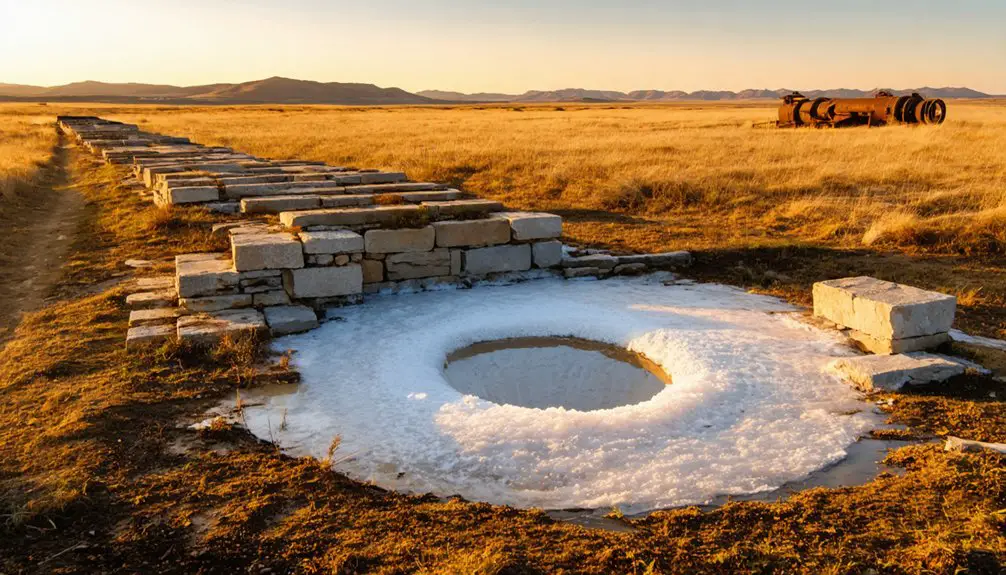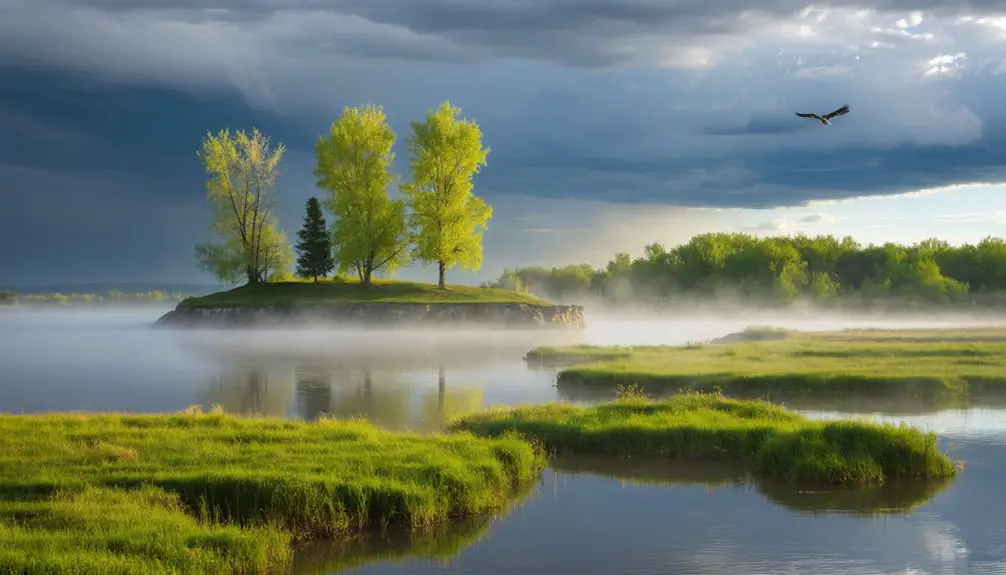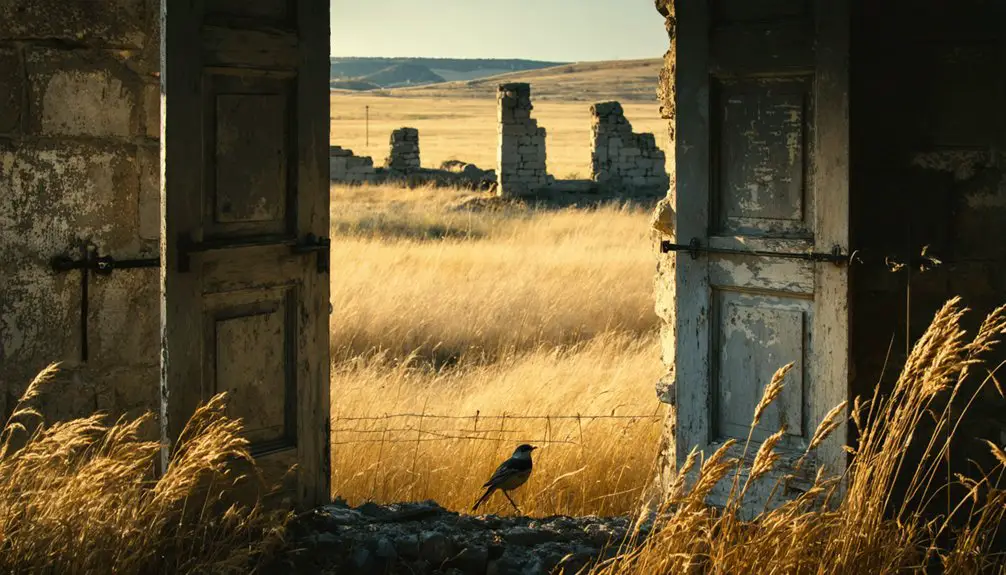You’ll discover the lost town of Waconda, Kansas beneath Waconda Lake, submerged in 1968 during the Glen Elder Dam project. Before its flooding, this sacred site featured a limestone-mounted mineral spring that Native Americans revered for its healing powers. The spring later became a thriving health resort with a 60-room sanitarium, drawing visitors nationwide. The spring’s remarkable legacy lives on through local exhibits and markers that tell its fascinating story.
Key Takeaways
- Waconda, Kansas became a ghost town after being submerged beneath Lake Waconda in 1968 during the Glen Elder Dam construction.
- The town featured a 60-room health resort sanitarium that drew visitors nationwide for its mineral spring’s healing properties.
- First settled in 1869-1870, Waconda developed from a sacred Native American site into a frontier community centered around the spring.
- The town’s decline began in the 1940s due to flooding issues and decreasing interest in traditional mineral spring treatments.
- All structures were demolished and submerged, with only historical markers and museum exhibits remaining to document the town’s existence.
The Sacred Spring’s Origins and Native Heritage
Before its submersion beneath Lake Waconda in 1968, Waconda Spring stood as a remarkable geological formation and sacred site in Mitchell County, Kansas. You’d have found this natural wonder perched atop a limestone mound rising 30-40 feet above the Solomon River valley floor, with a circular pool stretching 30-50 feet across.
The spring’s unique mineral properties, rich in calcium, magnesium, and other dissolved minerals, drew Native American tribes from across the Plains. They named it “Waconda,” meaning “Great Spirit” in the Kansa language, reflecting its deep spiritual significance. Native peoples believed the springs contained spirits of sacred animals that imparted wisdom to those who visited.
The Pawnee called it “Kitzawitzuk,” or “where the water is on the bank.” This neutral sacred ground served as a gathering place where tribes conducted healing ceremonies and spiritual rituals, casting valuable offerings into its depths. Many tribes believed the spring’s waters held medicinal healing powers, drawing visitors seeking cures for various ailments.
Legend of Waconda and Takota: A Tale of Star-Crossed Love
Among the sacred waters of Waconda Spring flows a timeless tale of forbidden love between two young Native Americans from rival tribes.
When Wakonda, a chief’s daughter, discovered an injured warrior named Takota near the Great Spirit Spring, she secretly nursed him back to health. Their growing love defied tribal boundaries and ancient rivalries.
Wakonda’s devotion and Takota’s sacrifice came to a tragic end when he formally sought her hand in marriage. The request sparked a fierce battle at the spring, where Takota fell mortally wounded by an arrow.
As he plunged into the sacred waters, Wakonda dove after him, never to resurface. Their story became legend, forever linking their spirits to the spring and inspiring generations with themes of love transcending tribal divisions.
A health spa resort was later built at the site in 1884, transforming the sacred spring into a commercial destination.
For centuries after, tribes including the Pawnee and Wichita made pilgrimages to these mystical waters seeking physical and spiritual healing.
Early Settlement and Pioneer Development
You’ll find the first permanent settlers of Waconda arrived in 1869-1870, with the Allen family and Pfeiffer staking early claims near the sacred springs where they initially lived in basic dugout shelters.
The harsh prairie conditions tested these pioneers’ resolve as they worked to establish permanent structures, gradually transforming the buffalo-rich grasslands into farmsteads and meeting places. Native Americans had long considered the area a sacred site for healing and spiritual ceremonies.
As more settlers arrived, the area’s first trading post emerged, marking Waconda’s evolution from pristine spiritual grounds to a growing frontier community centered around the springs’ commercial potential.
Burnham capitalized on the springs’ popularity by establishing a bottling works to distribute the mineral-rich water nationwide.
Pioneer Life and Hardships
Life on the Kansas frontier proved brutally challenging for settlers who arrived after the Civil War to establish homesteads near Waconda Springs.
You’d have found pioneer challenges at every turn – from constructing sod houses using tough prairie earth to enduring harsh weather extremes with limited resources.
Frontier survival meant adapting to isolation while facing threats from wildlife and occasional conflicts with Native Americans.
You would have struggled with scarce timber, limited water, and the demanding work of breaking tough prairie sod for farming.
Without nearby markets or medical care, you’d have relied on your own resourcefulness and community cooperation.
The physical demands of homesteading required constant adaptation to prairie conditions, while crop failures and extreme weather tested your resilience.
Legal disputes over land titles added another layer of uncertainty to frontier life.
The area’s sacred Waconda Springs site played a significant role in the lives of both Native Americans and early settlers who sought its healing waters.
The Pawnee tribe maintained strong spiritual connections to the area until they ceded land rights to the spring in 1833.
First Buildings Take Shape
When settlers first arrived at Waconda Springs after the Civil War, they encountered a landscape steeped in Native American heritage, where multiple tribes had long gathered for spiritual ceremonies.
You’ll find that the earliest pioneer architecture reflected both practicality and respect for this sacred land, with simple log structures strategically positioned near the spring and established trade routes.
The first community gathering places emerged as multi-purpose buildings – a store that doubled as a post office, and a double log dwelling house shared by pioneer families.
Local timber provided the raw materials for these essential structures, while blacksmith shops and auxiliary buildings soon followed. Like the pioneers who established the first store in Columbia, Kansas in 1855, these early settlers recognized the importance of commerce for the town’s growth.
A man named Burnham established the settlement’s first commercial venture, bottling the spring’s legendary healing waters for distribution beyond the region.
Truman and Emeline Allen were the first documented settlers in the area, making their home in a dugout dwelling in May 1869.
Trading Post Development
The establishment of trading posts near Waconda marked a significant phase in the region’s development, beginning with Cyprian Chouteau’s 1825 trading license for commerce with tribes west of the Missouri River.
You’ll find that the trading post economy initially centered on Native American trade, particularly with the Osage, as goods moved through the wilderness via pack horses without established roads.
The area’s commercial growth soon became entangled in pro-slavery conflict. When Kansas Territory organized, pro-slavery settlers from Missouri used Trading Post as their headquarters.
Despite the political tensions, economic development continued with a flour mill’s construction in 1857 and additional stores opening near the bridge by 1858.
The settlement served as an essential hub for both commerce and territorial disputes until its eventual decline, marked by the post office’s closure in 1902.
The Rise of Waconda’s Healing Waters

Rising majestically from the Kansas plains, Waconda Springs emerged as a natural wonder atop a 30-foot travertine mound, its mineral-rich waters flowing from a pool 15 to 20 feet deep.
You’d find a complex mineral composition of calcium, magnesium, iron, and silica, alongside sodium chloride, sulfate, and bicarbonate ions in its salty waters.
Native Plains tribes recognized the spring’s spiritual significance, naming it “Great Spirit Spring” and weaving the legend of Princess Wakonda’s sacrifice into their sacred traditions.
When settlers arrived, they quickly capitalized on these healing waters. You’ll find records of Burnham’s “Waconda Flier” bottling operation and McWilliams’ 1884 investment that transformed the site into a thriving sanitarium.
Medicine, Miracles, and the Mineral Spring Resort
Under the skilled management of proprietor G.W. Cooper and subsequent owners, Waconda Springs transformed into a premier health resort where you’d find sophisticated healing practices that blended traditional and modern treatments.
You could experience professional therapies ranging from hydrotherapy to electrotherapy, all centered around the spring’s unique mineral properties.
The water itself contained a powerful mix of calcium, magnesium, iron, silica, sodium chloride, sulfate, and bicarbonate. You’d find it flowing through every bathtub and serving station in the 60-room sanitarium.
The resort’s reputation for curing “most human ills” gained further mystique after a 1908 diver couldn’t locate the spring’s bottom. Their marketing even boasted a memorable slogan: “It will clean works until your works work.”
The water’s excellence earned recognition with a medal at the 1904 St. Louis World’s Fair.
Tribal Gatherings and Sacred Ceremonies

You’ll find that Waconda Springs served as a powerful spiritual nexus where Plains tribes like the Pawnee, Wichita, Kaw, and Cheyenne gathered annually for sacred ceremonies during buffalo migrations.
The tribes believed deeply in the spring’s supernatural healing powers, casting precious offerings like beads and weapons into its waters as gestures of respect to the Great Spirit.
At these gatherings, you’d have witnessed complex religious rituals featuring communal prayer, traditional dances, and sacred songs that strengthened intertribal bonds while allowing peaceful cultural exchange.
Sacred Rituals and Offerings
While multiple Native American tribes gathered at Waconda Springs, their sacred ceremonies shared common elements of prayer, offerings, and healing rituals centered around the spring’s mystical properties.
You’d find tribes making sacred offerings of food, natural objects, and symbolic items to communicate with animal spirits believed to dwell in the spring’s depths.
These spiritual healing ceremonies coincided with buffalo migrations, as tribes sought protection and success in their hunts. They’d perform directional rituals to honor the Great Spirit, believing the spring served as a portal between human and supernatural domains.
The site’s power stemmed from its connection to the sun spirit and animal spirits of the underworld, who granted healing knowledge and maintained nature’s balance through these sacred exchanges.
Healing Waters Unite Tribes
Throughout history, Waconda Springs served as a unifying sacred site where diverse tribes – including the Pawnee, Wichita, Kaw, Kiowa, Sioux, Arapaho, Comanche, Miami, and Crow – gathered annually to share in the spring’s legendary healing powers.
The sacred waters fostered tribal unity through shared spiritual healing practices, as Native peoples believed in their medicinal and supernatural properties.
You’ll find that these gatherings weren’t just about physical wellness – they provided vital opportunities for tribes to conduct peace councils, negotiate territories, and strengthen their bonds through collective ceremonies.
During buffalo migration seasons, tribes would coordinate their visits, combining essential hunting with spiritual renewal.
Through prayer, song, and ritual cleansing, these ceremonies transcended tribal boundaries and reinforced their cultural connections to the Great Spirit and each other.
The Golden Age of Health Tourism
During the late 19th and early 20th centuries, Waconda Springs transformed from a sacred Native American site into a thriving health tourism destination.
You’d find visitors flocking to the limestone mound where a 30-foot-wide spring promised healing through its mineral-rich waters. The site’s healing rituals evolved from ancient tribal ceremonies to modern hydrotherapy treatments at a sophisticated sanatorium and hotel.
Nature’s ancient healing spring beckoned visitors to its limestone throne, transforming sacred tribal waters into modern medical treatments.
After winning recognition at the 1904 St. Louis World’s Fair, Waconda’s popularity soared. The spring’s bottled tonic gained national attention, while the resort expanded its facilities to accommodate growing crowds.
However, tourism decline began in the 1940s as flooding threatened the valley and medical practices modernized. The once-bustling health resort closed its doors in 1964, shortly before the waters that had drawn so many seekers were forever submerged beneath Waconda Lake.
Engineering Progress and Environmental Cost

You’ll find a stark contrast between progress and preservation in the 1964 construction of Glen Elder Dam, which permanently submerged the historic Waconda Springs beneath its waters.
The Bureau of Reclamation’s decision to prioritize flood control over environmental concerns led to the demolition of existing structures and the dumping of debris into the spring pool before inundation.
This engineering feat, while achieving its flood control objectives, came at the cost of destroying a unique artesian spring system and erasing significant Native American cultural landmarks.
Dam Construction Reshapes History
While the construction of Glen Elder Dam marked a significant engineering achievement in Kansas’s water management history, it came at a profound cultural and environmental cost.
You’ll find that the dam’s impacts reshaped the region in both positive and negative ways. The $13.6 million project, completed in 1968, created Waconda Lake‘s massive 976,000 acre-foot reservoir, providing essential flood protection and irrigation for 21,000 acres.
Yet this progress meant sacrificing Waconda Springs, a unique worldwide phenomenon. Despite preservation efforts and attempts to designate it as a national monument, the historic mineral springs, along with its health spa and resort, vanished beneath the waters.
The dam’s construction effectively erased a piece of history sacred to both indigenous peoples and local communities.
Nature Versus Infrastructure Development
As engineering priorities clashed with environmental preservation in the Waconda region, the construction of Glen Elder Dam exemplified the stark tradeoffs between infrastructure development and natural heritage.
You’ll find that the unique artesian spring, once revered for its healing powers, vanished beneath reservoir waters along with critical wildlife habitats and indigenous cultural sites. The dam’s construction permanently altered the Solomon River’s natural flow, disrupting ecosystems and migration patterns while bulldozers pushed historic structures into the spring pool.
- The globally unique spring’s destruction highlights the irreversible cost of prioritizing flood control
- Natural artesian recharge systems were sacrificed for engineered water management
- Cultural preservation efforts now rely on replicas rather than authentic sites
- Native species lost essential floodplain habitats to reservoir creation
- Ecological restoration faces ongoing challenges due to permanent hydrological changes
Beneath the Waters: A Submerged Legacy
Deep beneath the waters of Glen Elder Reservoir lies Waconda Springs, a once-sacred site that vanished in the name of progress.
You won’t find the thirty-foot circular pool anymore, perched atop its distinctive hill where Native American tribes once gathered to seek spiritual knowledge and healing. The spring’s unique properties attracted up to 40 patients daily to its sanitarium and hotel, while its spiritual significance drew diverse tribes who respected it as neutral territory.
Despite the Bingesser family’s resistance and hydrologists’ testimony about the spring’s uniqueness, the site couldn’t escape its fate. In 1968, as part of the Glen Elder Dam project, bulldozers razed the buildings, dumped debris into the spring, and flood waters claimed this irreplaceable piece of Kansas heritage.
Preserving the Memory of Waconda Springs
How does a community preserve the memory of something that lies forever beneath the waters? Through dedicated cultural preservation efforts, Waconda Springs’ historical significance lives on in multiple ways.
You’ll find state markers commemorating the site, museum exhibits showcasing artifacts, and educational programs sharing the spring’s rich heritage. The Smithsonian Water/Ways exhibition helps maintain public awareness, while oral histories from descendants of key figures provide intimate glimpses into the past.
- Native American tribes’ sacred “Great Spirit” traditions and legends continue through storytelling
- Historical societies maintain extensive archives of photos, maps, and documents
- Educational markers near Waconda Lake inform visitors about the submerged spring
- Community events and lectures keep local history vibrant and relevant
- Research projects actively document both written records and personal narratives
Frequently Asked Questions
What Was the Average Cost of Staying at the Waconda Springs Resort?
You’d need a time machine to know exact rates, but Waconda Springs’ historical significance and resort amenities suggest you’d have paid premium prices comparable to other upscale health spas between 1884-1964.
How Many People Died or Disappeared at Waconda Springs?
You’ll find only two mystery deaths tied to local legends at the springs: Takota, a warrior killed by an arrow, and Wakonda, a princess who dove in after him and vanished.
Were Any Artifacts Recovered Before the Site Was Submerged?
Like scattered puzzle pieces lost forever, you’ll find limited evidence of formal artifact recovery at Waconda Springs. Reports don’t mention systematic archaeological excavations, though some souvenir hunters likely collected items before flooding.
What Was the Exact Chemical Composition of the Spring Water?
You’ll find high sodium chloride and calcium carbonate levels in the 1954 chemical analysis, plus therapeutic minerals like lithium, barium, bromine, strontium, iodine, boric acid and arsenic within the mineral content.
Did Any Famous Historical Figures Visit the Waconda Springs Resort?
You won’t find records of any famous visitors at Waconda Springs Resort. While the site held historical significance for Native Americans and health-seekers nationwide, no notable historical figures were documented there.
References
- https://www.hmdb.org/m.asp?m=123034
- http://www.lovewellhistory.com/blog/the-great-spirit-lake.html
- https://www.onlyinyourstate.com/state-pride/kansas/small-town-with-unique-history-ks
- https://www.waconda.com/waconda-springs.html
- https://mywildlifeproperty.com/waconda-lake-a-piece-of-history/
- https://lostkansas.ccrsdigitalprojects.com/sites/lostkansas/files/private_static/2022-12/LT_MC_WacondaSprings_Kelley.pdf
- https://www.humanitieskansas.org/get-involved/kansas-stories/nature/waconda-springs-from-sacred-to-submerged
- https://en.wikipedia.org/wiki/Waconda_Spring
- https://www.glenelder.com/waconda-springs.html
- https://readtheplaque.com/plaque/waconda-springs



